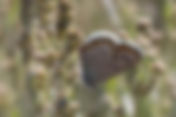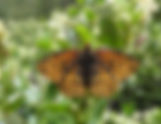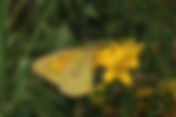181 results found with an empty search
- Northern Blue | ButterfliesofOregon
Photos, flight season, distribution and host plant information, conservation status, and identification tips for the Northern Blue butterfly. Gallery Prev Next Catherine Cr Rd, Wallowa Co, July 8 Northern Blue Plebejus idas Size: 1.0 - 1.25 inch wingspan Key ID features: Male deep violet-blue above with black marginal band and white fringe. Female brown above with scalloped orange marginal band, clearer and bolder on HW. Below, light bluish gray with black spots, with row of marginal spots that are black inwardly, then orange, and outwardly black with a patch of iridescent blue, lighter and less clear on FW. Similar species: Male Acmon and Lupine Blues have orange band on HW above, and females of those species have no orange on FW above. Melissa Blue has brighter orange borders and bolder iridescent patches on HW below. Anna's Blues don't occur east of the Cascades in NE Oregon. Host plant: May be using plants in the pea family and/or heath family . Habitat: Moist, cool montane meadows and forest openings, and dry meadows among conifers. Range: Found from Ochocos to Wallowas and Blue Mtns in NE Oregon. Season: Early June to late August Abundance: Common Conservation Status: Secure
- Mojave Sootywing | ButterfliesofOregon
Photos, flight season, distribution and host plant information, conservation status, and identification tips for the Mojave Sootywing butterfly. Gallery Prev Next Ana River, Lake Co, August 1 - female Mojave Sootywing Hesperopsis libya Size: Up to 1.5 inch wingspan Key ID features: Above very dark brown with several white spots or bars on FW (bolder on female). Below deep brown-black with a few white spots near the tip of the FW. Below, HW has several white patches or bars, with a single spot close to wing base. Similar species: Common Sootywing is smaller and darker, with white face. Host plant: Fourwing saltbush (Atriplex canescens ) and related shrubs. Habitat: Hot, dry sage and alkali flats, often near waterbody. Range: Southern half of Lake, Harney and Malheur counties. Season: Late July to early August Abundance: Uncommon Conservation Status: Secure
- Sagebrush Checkerspot | ButterfliesofOregon
Photos, flight season, distribution and host plant information, conservation status, and identification tips for the Sagebrush Checkerspot butterfly. Gallery Prev Next Big Indian Gorge, Harney Co, June 20 - male Sagebrush Checkerspot Chlosyne acastus Size: Up to 1.75 inch wingspan Key ID features: Male above, bands of pale orange and yellow-orange, separated by black lines, crescents and checks . Basal 1/3 of HW above sometimes black with little orange. Male often lighter than female above. Below bands of chalk-white and brick red with black veins and edges. More white below than other similar species. Similar species: Northern Checkerspot darker above, and with off-white rather than white below. Host plant: Several species including green rabbitbrush (Chrysothamnus viscidiflorus ), gray rabbitbrush (Ericameria nauseosa ), desert yellow fleabane (Erigeron linearis ) and asters in the genus Dieteria . Habitat: Sage desert, pinyon-juniper savanna, washes, gulches, canyons and brushy flats. Range: Mostly below 5000 feet in SE Oregon deserts, and below 3000 feet in Columbia and Snake r iver basins . Season: Late April to late June Abundance: Common Conservation Status: Secure
- California Marble | ButterfliesofOregon
Photos, flight season, distribution and host plant information, conservation status, and identification tips for the California Marble butterfly. Gallery Prev Next Illinois River, Josephine Co, May 5 California Marble Euchloe hyantis AKA Pearly Marble Size: 1.25 - 1.5 inches wingspan Key ID features: Above, off-white with dark gray pattern on FW tip and narrow black bar in forewing cell with no white scaling. Below, dark green marbling with minimal yellowish wash against pearly white background and yellow veins. Similar species: Large Marble is notably larger. Desert Marble lacks pearly or shiny look to white areas between darker green marbling below, and is not found in Josephine County. Host plant: Streptanthus (Jewel-flower) and possibly Arabis and Draba species. Habitat: Open montane and foothill slopes, dry meadows and canyons. Range: Primarily found in Josephine County near Jewel-flower. Season: Mid-March to early June Abundance: Common Conservation Status: Secure
- Garita Skipperling | ButterfliesofOregon
Photos, flight season, distribution and host plant information, conservation status, and identification tips for the Garita Skipperling butterfly. Gallery Prev Next Izzee Rd Meadow, Grant Co, June 29 Garita Skipperling Oarisma garita Size: Up to 1 inch wingspan Key ID features: Small and triangular . Above, dark brown with brassy sheen, and veins that look darker than wings. Below lighter orange-brown, veins lighter than ground color. Similar species: No other similar species in Oregon. Host plant: Grass and sedge species. Habitat: Montane mid-elevation grasslands, moist pastures, weedy marshes and fields. Range: Grassy areas north and west of Wallowa Mtns. Season: Early June to early August Abundance: Uncommon Conservation Status: Secure
- Melissa's Blue | ButterfliesofOregon
Photos, flight season, distribution and host plant information, conservation status, and identification tips for the Melissa's Blue butterfly. Gallery Prev Next Millican Flats, Deschutes Co, June 21 Melissa's Blue Plebejus melissa Size: 1.0 - 1.25 inch wingspan Key ID features: Male shiny violet-blue above with black marginal line and white fringe. Female brown above with scalloped orange marginal band, clearer and bolder on HW. Below, brownish-gray with bold black spots, with submarginal row of orange patches, bordered inwardly with black and a row of black spots, which on HW have bold patch of iridescent blue bordered by black. Similar species: Male Acmon and Lupine Blues have orange band on HW above, and females of those species have no orange on FW above. Orange borders of Northern Blues below are less bold. Host plant: Legumes, including lupines, lotuses, milkvetches and many others . Habitat: Hot, low to mid-elevation prairies and meadows, as well as disturbed areas like agricultural fields. Range: Found throughout eastern Oregon and in southern Klamath County, and Jackson County. Season: Late April to late September Abundance: Common Conservation Status: Secure
- Western White | ButterfliesofOregon
Photos, flight season, distribution and host plant information, conservation status, and identification tips for the Western White butterfly. Gallery Prev Next Eagle Cap Wilderness, Wallowa Co, Aug 26 - female Western White Pontia occidentalis Size: 1.25 - 1.75 inches wingspan Key ID features: Above, male white with black or gray markings on forewing, female has more extensive markings on both wings. Below dark overscaling creates gray-green margins along hindwing veins, darker in spring. Similar species: Co-occurs with Checkered White in SE Oregon. The two species are not separable in flight. Female Checkered White is less sharply marked, often with olive or brown shades above instead of the gray-black of Western. Male Checkered White has narrower gray marks on the forewing margins with more white in between, and forewing markings are less extensive in general. Host plant: Many native species in the mustard family. Habitat: Open habitats, including woodland openings, mountain meadows, and barren areas above tree line. Range: Throughout Oregon west of the Cascade Crest. Season: Mid-March to mid-September Abundance: Common Conservation Status: Secure
- Cascadia Blue | ButterfliesofOregon
Photos, flight season, distribution and host plant information, conservation status, and identification tips for the Glaucon Blue butterfly. Gallery Prev Next Izee Rd Meadow, Grant Co, July 1 Cascadia Blue Euphilotes heracleoides Size: Up to 1.0 inch wingspan Key ID features: Small. Male blue above with narrow dark wing borders, little or no orange along trailing edge of HW. Female dark brown above with prominent orange zigzag along trailing margin. Both sexes have checked fringe on FW. Below bluish-gray with bold black spots, larger on FW, and broad orange submarginal line on HW. Similar species: Best told from other Euphilotes blues by host-plant association, location and flight period. Host plant: Eriogonum heracleoides (Parsnip-flower buckwheat). Habitat: Well-drained sites where host plant grows, including high plateaus, ridges and roadsides. Range: All of northeast Oregon, and in Warner Mountains and southern Deschutes County Season: Late April to late June Abundance: Common Conservation Status: Secure
- Queen Alexandra's Sulphur | ButterfliesofOregon
Photos, flight season, distribution and host plant information, conservation status, and identification tips for the Queen Alexandra's Sulphur butterfly. Gallery Prev Next Mtn Lakes Wilderness, Klamath Co, August 15 Queen Alexandra's Sulphur Colias alexandra Size: 2.0 - 2.8 inches wingspan Key ID features: Larger than any other Oregon sulphur, with more pointed FW. Below HW discal spot is white (not pearly) with no satellite spot, often unrimmed. Below HW has heavy black overscaling, giving strong green cast. Similar species: Clouded Sulphurs are smaller and have double ring around discal spot on HW below. Western Sulphurs are smaller and often have brighter pink wing borders. Pink-edged Sulphurs have more rounded wings, lack black overscaling below and have bright pink wing borders. Host plant: Various species in the pea family, especially Astragalus (milkvetch) and Medicago (alfalfa). Habitat: Meadows, roadsides, dry steppe slopes and forest glades. Range: Throughout eastern Oregon. Season: mid-April to mid-September Abundance: Common Conservation Status: Secure
- Oreas Comma | ButterfliesofOregon
Photos, flight season, distribution and host plant information, conservation status, and identification tips for the Oreas Comma butterfly. Gallery Prev Next Mt. Hebo, Tillamook Co, August 13, ssp. silenus Oreas Comma Polygonia oreas AKA Oreas Anglewing Size: Up to 2 inch wingspan Key ID features: Above orange with black blotches and spots, often with very jagged wing edges. FW above has yellow patches adjacent to dark marginal band. HW above has submarginal row of yellow/orange crescent-shaped chevrons within brown to black marginal band. Below dark chocolate or dark gray to black, with lighter gray striations, and prominent white flattened "v" with no hooks (usually pointed at the bottom, often looking like a gull in flight), in center of HW. Similar species: Darker below than other comma species, white "v" mark on HW below lacks barbs. Other comma species either have stronger green submarginal shading below or the "comma" mark on HW below is curved (not a pointed "v") or barbed or both. Other commas species have less jagged wing edges, often looking smooth between major points. Host plant: Currant species (Ribes ), including R. divericatum (straggly gooseberry), and R. lacustre (swamp gooseberry) . Habitat: Forest fringes, especially in older stands, riparian areas and ravines, subalpine meadows. Range: Coast Range, Willamette Valley, Western Cascades, east slope of Cascades, Wallowa Mtns, Blue Mtns . Season: Late February to mid-September Abundance: Uncommon Conservation Status: Secure
- Orange Sulphur | ButterfliesofOregon
Photos, flight season, distribution and host plant information, conservation status, and identification tips for the Orange Sulphur butterfly. Gallery Prev Next Upper Mule Prairie, Lane Co, August 2 - male Orange Sulphur Colias eurytheme Size: 1.3 - 2.3 inches wingspan Key ID features: Males above, bright orange with unbroken black border. Females above either bright orange or greenish white with "window" spots breaking up black border. Below, central pearly "discal" spot on HW with small satellite spot, and two pinkish-brown rings, and submarginal row of black or brown "eurytheme spots." Similar species: Western Sulphur and Clouded Sulphur are lemony yellow, lacking orange. White females difficult to separate from Clouded Sulphur, but often HW border is stronger in female Orange Sulphur. Host plant: Many species in the pea family. Habitat: Most commonly seen in meadows, pastures, fields and other open habitats. Range: Throughout Oregon Season: Late March to early November Abundance: Common Conservation Status: Secure
- Butterflies of Oregon | Photos • Biology • Indentification
Butterflies of Oregon has exquisite photos and information about all of Oregon's native butterfly species, with information about the biology, distribution and identification of each species. A lively blog provides seasonal stories and updates from the field. Butterflies of Oregon New Book Now Available ! Welcome to Butterflies of Oregon, a resource for Oregon butterfly enthusiasts, with photos of all of Oregon's regularly occurring butterfly species and information to help you find and identify them. Butterflies of Oregon also shares stories of the author's attempt to photograph all of Oregon's butterfly species in the wilds of Oregon. Thanks for visiting! www.butterfliesoforegon.com Subscribe to Blog Thanks for submitting! Email Us











